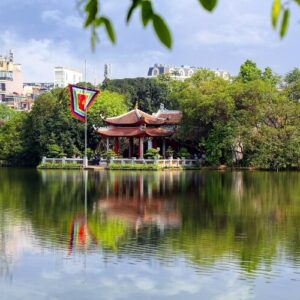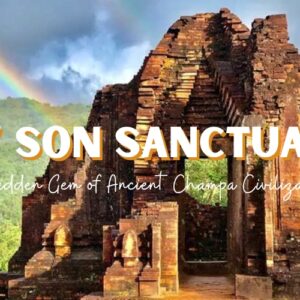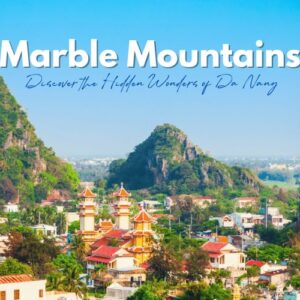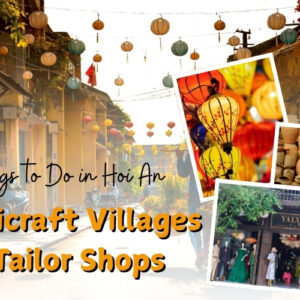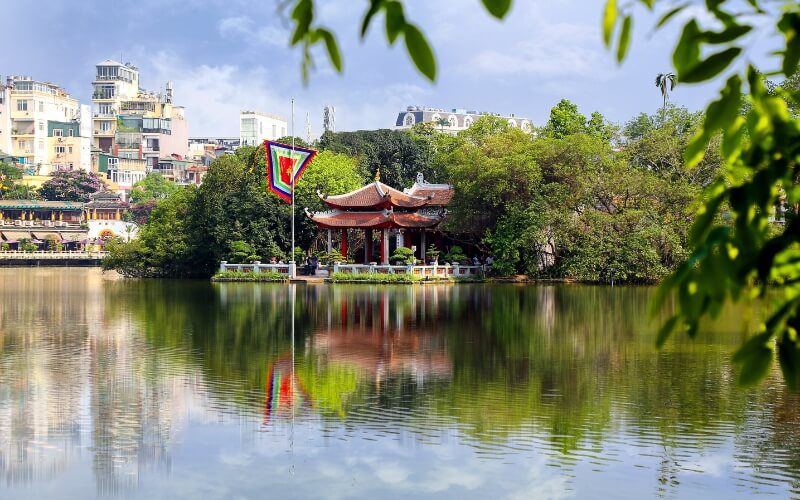
Ngoc Son Temple, also known as the Temple of Jade Mountain, is a historic and culturally significant landmark located in the heart of Hanoi, Vietnam. Situated on a small islet in the picturesque Hoan Kiem Lake, Ngoc Son Temple holds great religious and historical importance to the local community. Whether you are seeking historical insights, or simply a moment of tranquility amidst the bustling city during your tour in Hanoi, Ngoc Son Temple offers a captivating experience that showcases the rich culture of Vietnam.
Where is Ngoc Son Temple Located?
Ngoc Son Temple, also known as Temple of the Jade Mountain, is situated on a small island in the middle of Hoan Kiem Lake, which is in the historic center of Hanoi. Connected to the shore by the iconic red-painted The Huc Bridge, Ngoc Son Temple is a significant cultural and religious landmark in Hanoi, that attracts many visitors and locals alike.
The History of Ngoc Son Temple
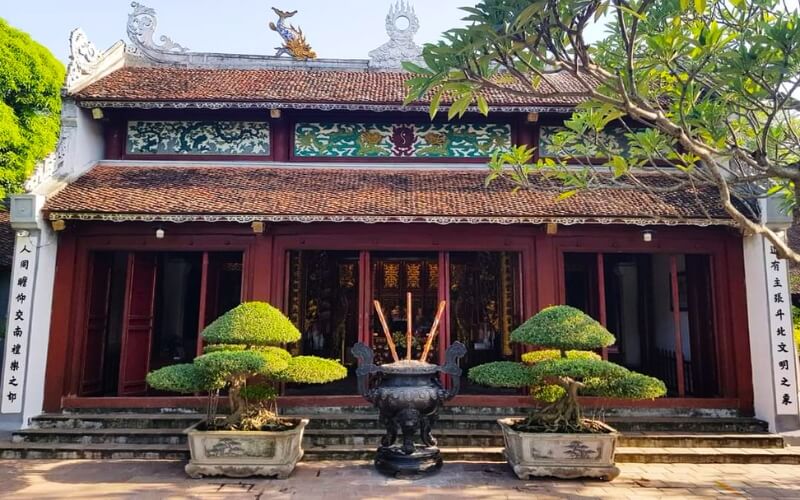
History of Ngoc Son Temple
Ngoc Son Temple is dedicated to the worship of Van Xuong De Quan, a deity believed to bring happiness and prosperity to scholars. Additionally, the temple serves as a commemoration for General Tran Hung Dao (1231-1300). According to historical stelae found at the site, the construction of Ngoc Son Temple began in the autumn of 1841. Throughout its history, the temple has undergone multiple renovations and expansions. In 1865, notable additions such as the Tran Ba Pavilion, The Huc Bridge, and the Pen Tower were constructed, transforming the temple into a substantial architectural complex situated on the shores of Hoan Kiem Lake.
Main Highlights in Ngoc Son Temple Complex
Nghi Mon Gate
Nghi Mon Gate stands proudly with its two columns and flanking walls, serving as the entrance to the complex. Adorned with intricate Chinese characters, the pillars, and walls exude a sense of elegance and significance.
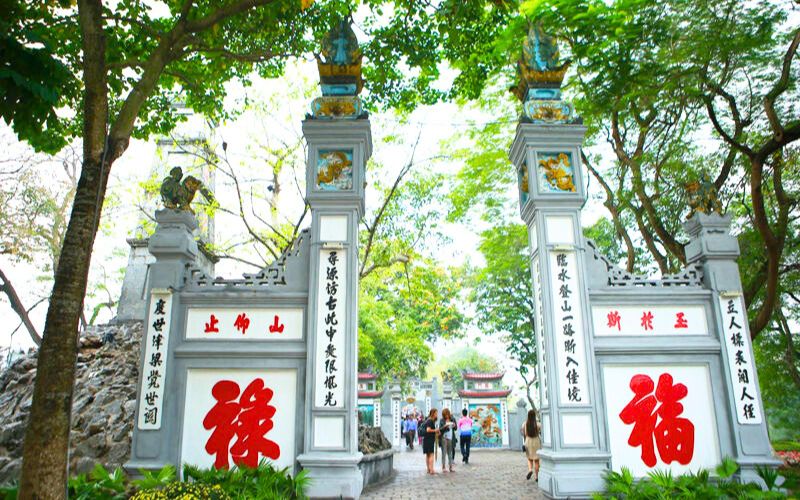
Nghi Mon Gate
Upon stepping inside, your eyes will be drawn to the captivating Pen Tower positioned on the left. Majestically erected upon a hill crafted from stones, this tower was meticulously built in 1865 during the reign of King Tu Duc (1829-1883). Delicately etched onto the tower’s surface are three meaningful Chinese characters that translate to “Write onto the sky.” This inscription pays homage to the profound role of literature and commemorates the unwavering contributions of the Trinh Lords (1545-1787) in defending against invasions from the north.
Long Mon Ho Bang Gate
Continuing beyond the Pen Tower, you will arrive at the remarkable Long Mon Ho Bang Gate. This gate, flanked by two columns and walls, showcases an architectural style reminiscent of pagodas. Upon closer inspection, you will see two Chinese characters gracefully engraved atop the walls, symbolizing the “Dragon Gate” (Long Mon). Additionally, on the left wall, a carved image of a white tiger accompanied by Chinese characters representing the “Tiger Board” (Ho Bang) catches the eye. The Long Mon Ho Bang holds significant meaning as they represent the pursuit of knowledge and academic success. These symbols serve as an inspiration for young individuals, encouraging them to learn.
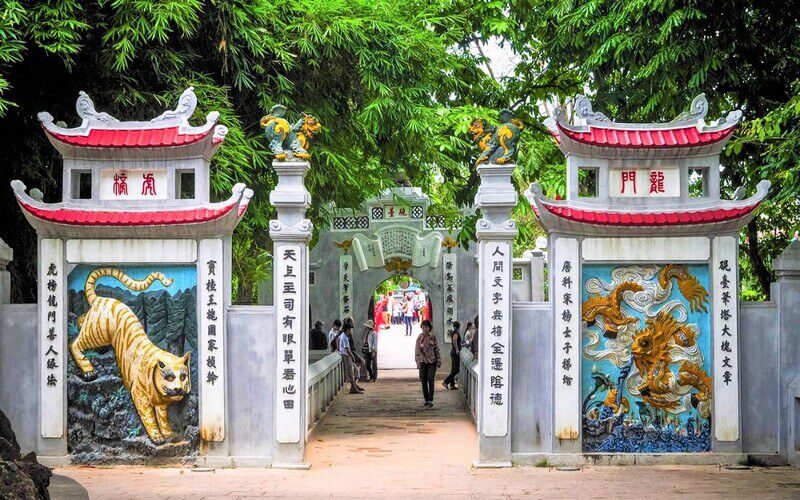
Long Mon Ho Bang Gate
Dai Nghien – Thap But
In close proximity to the Pen Tower, near the entrance of The Huc Bridge, you will encounter a gate known as Dai Nghien Gate that leads to Ngoc Son Temple. A significant feature of this gate is the presence of a stone ink pot, crafted from exquisite blue stone. Resting upon the backs of three stone toads, arranged in a manner reminiscent of sturdy legs, the ink pot represents stability and strength. Carefully carved into the center of the pot are 64 Chinese characters, composing a poem authored by the renowned writer Nguyen Van Sieu (1799-1872). It is believed that on the morning of the 5th day of the 5th lunar month, as the sun rises, the stone feather pen atop the Pen Tower (Thap But) casts a distinct shadow that aligns precisely with the ink pot.
The Huc Bridge
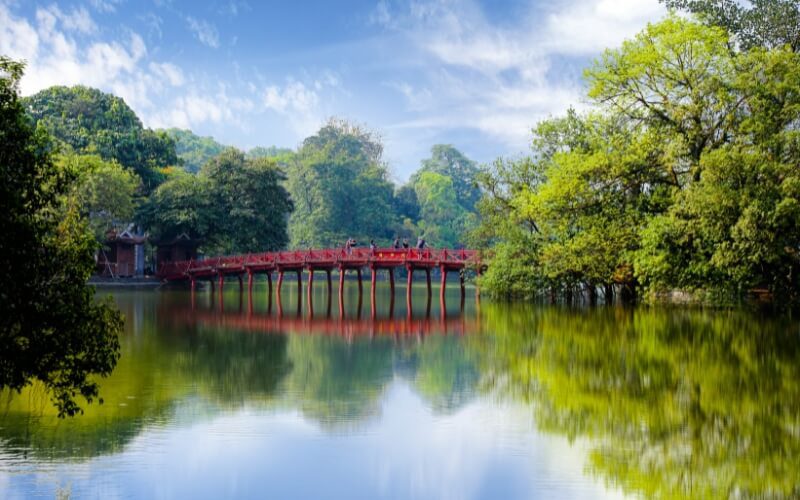
The Huc Bridge
The Huc Bridge holds profound symbolism as a representation of the Sun God. Its name, “The Huc,” translates to “where sunlight beams in the early morning”. Constructed primarily from wood, the bridge features a distinctive curved design and is painted in a vibrant shade of red. Exploring The Huc Bridge in the morning grants you the opportunity to witness the beauty of nature awakening and bask in the serene atmosphere that surrounds this remarkable landmark.
Dac Nguyet Lau Gate
After crossing The Huc Bridge, a picturesque path leads to Dac Nguyet Lau Gate, a charming entranceway adorned by the shade of an ancient banyan tree. This petite gate stands gracefully with two stories, each offering its own unique features. The upper story of Dac Nguyet Lau Gate showcases a captivating design. It boasts two layers of elegantly crafted roofs, adding a touch of architectural splendor. At the center of the upper story, a round window catches the eye, framed by intricate depictions of phoenixes and dragons.
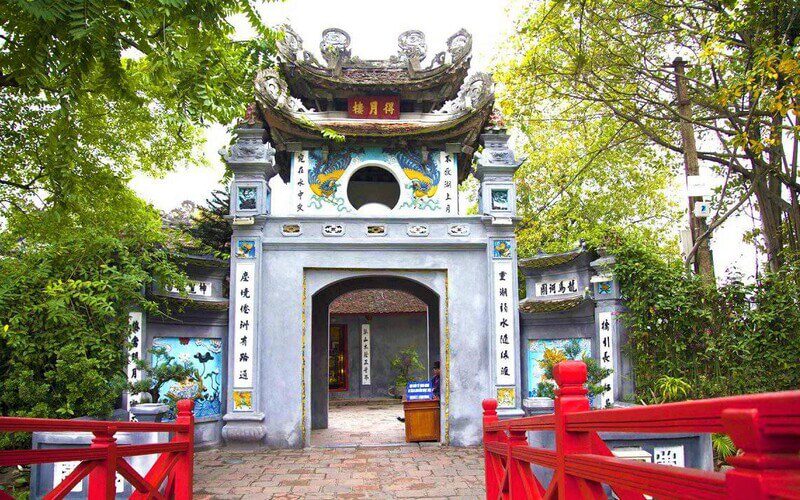
Dac Nguyet Lau Gate
Tran Ba Pavilion
Tran Ba Pavilion, aptly named to signify its role in “warding off the sea waves”, was constructed as a steadfast defense against negative cultural influences during the feudal era. This pavilion boasts a square shape, characterized by two tiers of intricately designed roofs, which rest upon a foundation of four sturdy stone columns and four wooden columns.
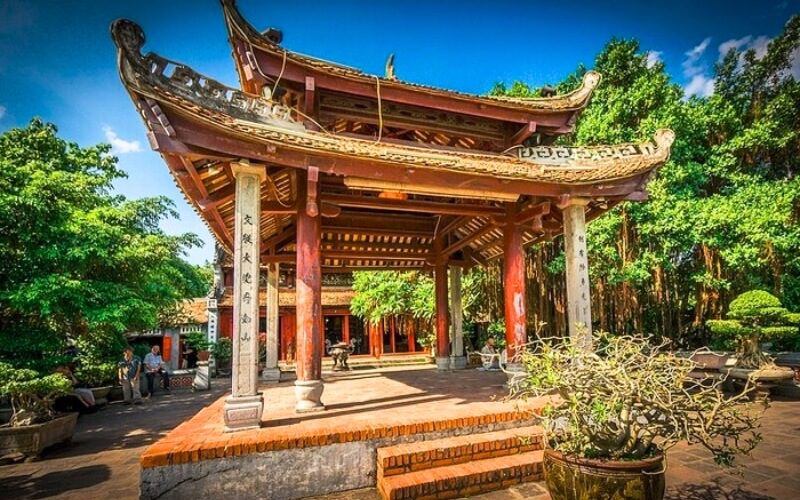
Tran Ba Pavilion
Main Space of the Temple
The central section of Ngoc Son Temple comprises two adjacent temple buildings, each with its own distinct purpose. One of these temple buildings is devoted to the worship of General Tran Hung Dao and Van Xuong De Quan, housing their revered statues for visitors to admire and pay respects. The second temple building serves as a unique exhibition area, showcasing the preserved bodies of two magnificent turtles that once inhabited Hoan Kiem Lake. These revered creatures are placed within the glass boxes, providing a clear view for visitors to witness their splendor.
Opening Hours and Fares
For tourists intending to explore Ngoc Son Temple, it is important to be aware of the ticket booth located in front of The Huc Bridge, which leads to Dac Nguyet Lau. If you simply admire the scenic beauty from the bridge without venturing further into the temple, purchasing a ticket is not necessary.
Here are some essential details to consider:
- Opening hours: Ngoc Son Temple is open from Monday to Sunday, operating between 8 am and 6 pm.
- Admission fees: Currently, the ticket price for visiting Ngoc Son Temple is listed at 30,000 VND per adult. However, it is important to note that children under 15 years old can enter free of charge.
Must-try Activities near Ngoc Son Temple
Take a walk around Hoan Kiem Lake
Hoan Kiem Lake, situated next to Ngoc Son Temple, is indeed a beautiful and serene destination in Hanoi. A leisurely stroll around the lake offers a peaceful escape from the bustling streets and provides a chance to immerse yourself in nature while enjoying stunning views.
The surroundings of Hoan Kiem Lake are meticulously landscaped, offering a tranquil setting for a leisurely walk. You can follow the scenic path that encircles the lake, admiring the picturesque scenery and the architectural gems that dot the shoreline. As you explore, you’ll likely encounter locals engaging in various activities around the lake. In the early mornings, you can witness residents practicing Tai Chi or other forms of exercise, enjoying the serenity of the surroundings.
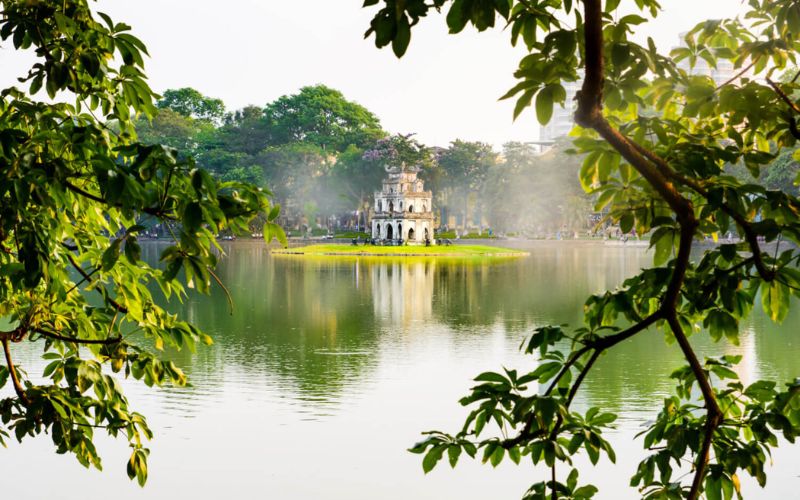
Hoan Kiem Lake
Explore the Old Quarter
Located near Ngoc Son Temple, the Old Quarter is easily accessible and offers a delightful blend of history, culture, and everyday life. As you stroll through its narrow lanes, you’ll find yourself immersed in a sensory overload of sights, sounds, and aromas.
The streets are lined with an array of shops, ranging from silk merchants to art galleries, offering a wide variety of traditional Vietnamese handicrafts, clothing, and souvenirs. Whether you’re searching for unique gifts or simply want to indulge in some retail therapy, the Old Quarter has something to cater to every taste.
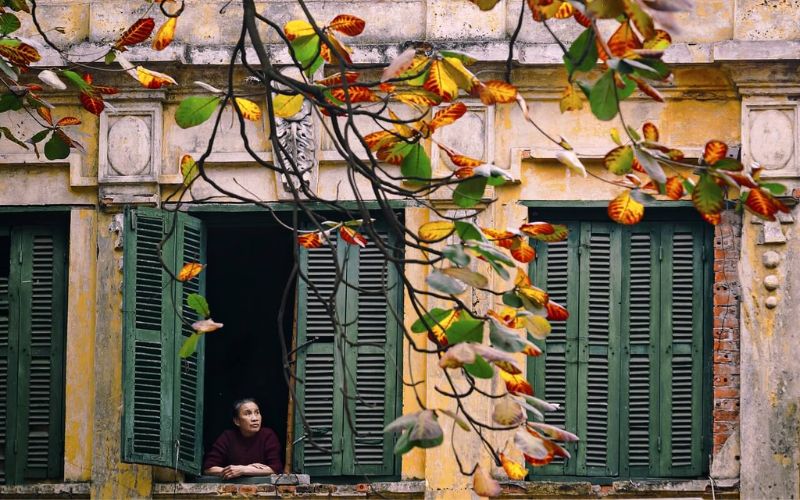
A corner of Hanoi Old quarter
Visit the Thang Long Water Puppet Theater
Thang Long Water Puppet Theater is indeed a captivating cultural attraction in Hanoi, conveniently located within a short stroll from Ngoc Son Temple. Water puppetry is a traditional Vietnamese art form that dates back to the 11th century and has been passed down through generations.
At the theater, you can immerse yourself in the enchanting world of water puppetry, where wooden puppets are brought to life on a stage filled with water. The puppets are controlled by skilled puppeteers who stand behind a bamboo screen, skillfully maneuvering them with long poles and strings. The water serves as the stage, adding a unique dimension to the performance as the puppets appear to glide, dance, and interact with one another.
There are many shows at the theater, such as Teu, Vinh Quy Bai To, Agriculture, Dragon Dream, etc. Each of them reflects a traditional Vietnamese story with the showing schedule changing weekly. To find a suitable show, you can refer to its official website here.
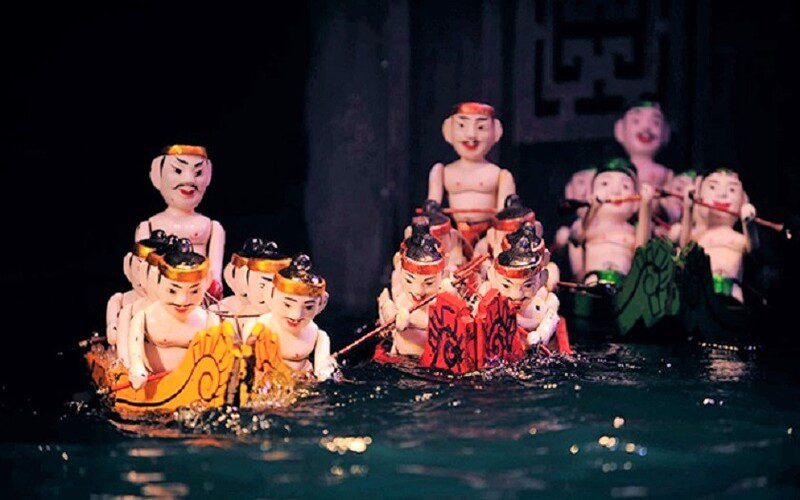
Thang Long Water Puppet Theater
Getting to Ngoc Son Temple
Ngoc Son Temple benefits from its central location in Hanoi, making it conveniently accessible for visitors. Transportation to the temple is relatively straightforward due to its prime position in the city center.
On Foot
If you are staying in the Old Quarter or the surrounding areas of Hanoi, you can easily walk to Ngoc Son Temple. Head towards Hoan Kiem Lake, and you’ll see the iconic red-painted The Huc Bridge that leads to the temple.
By Taxi/Grab/Private car
Taxis and ride-hailing services like Grab are readily available in Hanoi. Simply provide the address or the name “Ngoc Son Temple” to the driver, and they will take you directly to the temple. Be aware of traffic conditions, especially during peak hours.
To maximize your time and enjoy greater flexibility, you have the option of renting a car with a private driver. This choice allows for proactive pick-up and drop-off arrangements, providing you with a convenient time to explore the city center and its surrounding areas. Furthermore, the knowledgeable drivers can also serve as guides, offering insights into Hanoi’s rich history, vibrant culture, local cuisine, and the warm hospitality of its people. Contact us for more details!
By Cyclo/Electric Car
For a unique experience, you can hire a cyclo (a three-wheeled bicycle taxi) or take an electric car ride from the Old Quarter to Hoan Kiem Lake. The drivers can drop you off near The Huc Bridge, where you can cross over to reach Ngoc Son Temple.
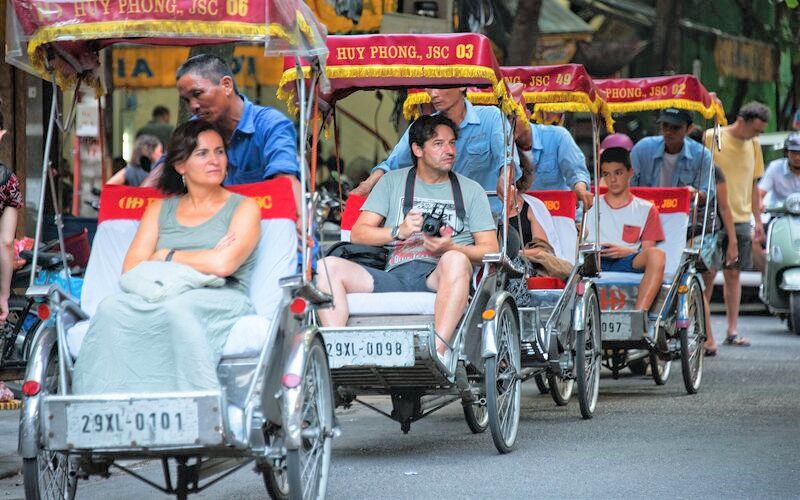
Cyclo in Old Quater
The architecture of Ngoc Son Temple exudes an enchanting ancient beauty that perfectly blends with its natural surroundings. It is not only a testament to the architectural prowess of the past, but also a repository of historical and cultural symbols that resonate with the wisdom and ideals of the scholars. Are you ready to start an adventure to discover the wonders of Hanoi? Explore these enchanting destinations with our careful Hanoi city tours. If you’re looking for a personalized experience, feel free to contact us, and we’ll be more than happy to create a tailor-made Hanoi tour itinerary just for you.
